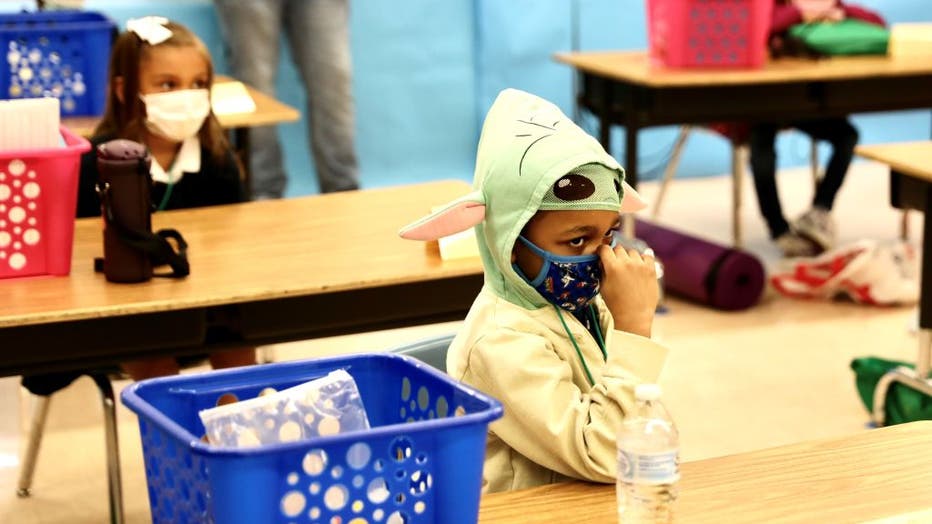NIH funds new COVID-19 testing initiative to get students back to classrooms in vulnerable areas
CDC releases updated guidance on reopening schools
The CDC on shared updated guidance on reopening schools in the middle of a pandemic, emphasizing mask-wearing and social distancing and saying vaccination of teachers is important but not a prerequisite.
The National Institutes of Health is awarding millions of dollars to nearly a dozen schools across the country to build evidence on how students and teachers can safely return to school amid the COVID-19 pandemic.
Ten institutions in eight states, all in vulnerable and underserved areas, are getting a portion of $33 million to be involved. The project is a COVID-19 testing initiative in which researchers hope to learn how to best test students, teachers and staff for COVID-19.
Some of the schools will focus on at-home testing, while others will use pooled, in-school testing approaches, the NIH said. Both nasal and saliva tests will be used, and only children who have prior consent from a parent will be tested.
"Establishing frequent COVID-19 testing protocols for schools in vulnerable and underserved communities is essential to the safe return to school effort, and these projects will inform decision makers on the best strategies to accomplish this," said Eliseo J. Pérez-Stable, M.D., director of NIH’s National Institute on Minority Health and Health Disparities. He is also co-chair of the program that oversees the awards, RADx-UP, which stands for the Rapid Acceleration of Diagnostics Underserved Populations.
"Many children have inequitable access to reliable virtual learning, and it is important they are able to participate safely in person while also maintaining the health and safety of the of the school and general communities," he added.

LOS ANGELES, April 13, 2021 -- Students attend an in-person class in a school in Los Angeles, California, the United States, on April 13, 2021. Since the outbreak of the COVID-19 pandemic for the first time in more than a year, some Los Angeles schoo
The COVID-19 pandemic has thrown two school years off course now, and some districts are already planning for the possibility of a third next fall.
President Joe Biden has made reopening schools a top priority, but administrators say there is much to consider as new strains of the coronavirus appear and as some teachers still wait to be vaccinated.
For example, Michigan’s largest school district, the Detroit Public Schools Community District, switched back to virtual learning earlier this month when the city’s percent positive rate hit 15%. The district had welcomed students back to in-person instruction about a month ago when the rate fell below 3%.
But now the state is seeing one of the sharpest surges in the country. Some health officials there have said the UK variant, B.1.1.7, is partly to blame as it is more contagious and affects younger people.
RELATED: UK variant a 'brand new ballgame,' infecting children in US 'very readily,' epidemiologist warns
And with the B.1.1.7 variant affecting younger people - including children - many administrators are left wondering now too when their students will be able to get vaccinated.
Both Pfizer and Moderna have completed enrollment for studies of their vaccines in children ages 12 and older and are expected to release data in the months ahead. Both are also now studying their shots in children under 12 — including babies as young as 6 months.
Johnson & Johnson also recently began testing its shot in older children and teenagers, though its vaccine is currently on pause as U.S. regulators investigate blood clot reports.
RELATED: J&J COVID-19 vaccine pause: What to know if you received shot, have future appointment and more
The pivot to virtual learning last March has proved a lifeline for the education system, but concerns have grown with each passing month about the effects on racial inequities, students’ academic performance, attendance and their overall well being. Guidance on how to safely reopen from federal, state and locals leaders hasn’t always been clear or cohesive either.
Just last month, the Centers for Disease Control and Prevention changed its guidance and said students can safely sit just 3 feet apart from each other inside the classroom, instead of the usual recommendation of staying 6 feet away from one another at sporting events, assemblies, lunch or chorus practice.
While some studies are looking at best practices for physical distancing and other ways to keep children safe at school, these NIH projects will focus solely on how to best implement COVID-19 testing among the students, teachers and staff.
Schools participating in the NIH COVID-19 testing initiative include early childhood education and kindergarten through grade 12, whose student bodies range from hundreds to thousands. Schools include public, chartered, special education and pediatric complex care that serve children in urban, rural and tribal communities, the NIH said.
Populations are also racially and ethnically diverse, including African Americans, American Indians/Alaska Natives, Latinos/Latinas, and Asian Americans.
You can read more about the testing initiative here.

